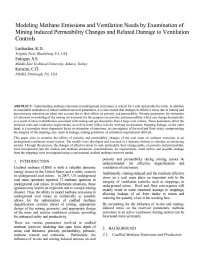Mining Publication: Modeling Methane Emissions and Ventilation Needs by Examination of Mining Induced Permeability Changes and Related Damage to Ventilation Controls
Original creation date: June 2009
Authors: KD Luxbacher, SS Erdogan, C� Karacan
NIOSHTIC2 Number: 20036265
43rd U.S. Rock Mechanics Symposium/4th U.S.-Canada Rock Mechanics Symposium, June 28 - July 1, 2009, Ashland, North Carolina, ARMA 09-146. Alexandria, VA: American Rock Mechanics Association, 2009; :1-8
Understanding methane emissions in underground coal mines is critical for a safe and productive mine. In addition to reasonable estimation of initial coalbed reservoir parameters, it is also crucial that changes in effective stress due to mining and pore pressure reduction are taken into account due to their effects on porosity and permeability. Primary parameters for estimation of emissions or modeling of the mining environment for this purpose are porosity and permeability which can change dramatically as a result of stress redistribution associated with mining and gas desorption from a large coal volume. These parameters affect the emission rates and ventilation requirements, as well as water inflow into the working environment. Stopping leakage, on the other hand, is a secondary stress dependent factor in estimation of emissions, as convergence of the roof and floor strata, compromising the integrity of the stopping, may result in leakage, making prediction of ventilation requirements difficult. This paper aims to examine the effects of porosity and permeability changes of the coal seam on methane emissions in an underground continuous miner section. The models were developed and executed in a dynamic fashion to simulate an advancing section. Through this process, the changes of effective stress in coal, particularly their change paths, on porosity and permeability were incorporated into the models and methane emissions, concentrations, air requirements, water inflow and possible leakage from the stoppings were investigated using a conventional coalbed methane reservoir model.

NIOSHTIC2 Number: 20036265
43rd U.S. Rock Mechanics Symposium/4th U.S.-Canada Rock Mechanics Symposium, June 28 - July 1, 2009, Ashland, North Carolina, ARMA 09-146. Alexandria, VA: American Rock Mechanics Association, 2009; :1-8
- Development and Application of Reservoir Models and Artificial Neural Networks for Optimizing Ventilation Air Requirements in Development Mining of Coal Seams
- The Direct Method of Determining Methane Content of Coalbeds for Ventilation Design
- Evaluation of the Relative Importance of Coalbed Reservoir Parameters for Prediction of Methane Inflow Rates During Mining of Longwall Development Entries
- Experimental and Modeling Investigation of the Effect of Ventilation on Smoke Rollback in a Mine Entry
- Methane Emission Rate Studies in a Northern West Virginia Mine
- Modeling and Prediction of Ventilation Methane Emissions of U.S. Longwall Mines Using Supervised Artificial Neural Networks
- A New Methane Control and Prediction Software Suite for Longwall Mines
- Reservoir Engineering Considerations for Coal Seam Degasification and Methane Control in Underground Mines
- Reservoir Modeling-Based Prediction and Optimization of Ventilation Requirements During Development Mining in Underground Coal Mines
- Reservoir Rock Properties of Coal Measure Strata of the Lower Monongahela Group, Greene County (Southwestern Pennsylvania), from Methane Control and Production Perspectives